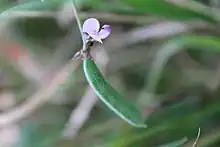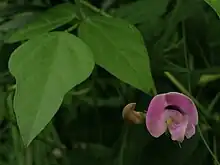Strophostyles
Strophostyles is monophyletic three-species genus of flowering plants in the family Fabaceae, subfamily Faboideae.[3][4] Common names for the genus include wild bean and fuzzybean (due to their pubescent pods and seed coverings).[4][5] It consists of annual and perennial herbaceous vines, ranging in their native distribution from Nevada, east to Florida, and north to the Great Lakes and eastern Canada.[5] The etymology of the name is strophe (turning) + stylos (style), referring to the curve of the style within the keel petal.[6]
| Strophostyles | |
|---|---|
 | |
| Scientific classification | |
| Kingdom: | Plantae |
| Clade: | Tracheophytes |
| Clade: | Angiosperms |
| Clade: | Eudicots |
| Clade: | Rosids |
| Order: | Fabales |
| Family: | Fabaceae |
| Subfamily: | Faboideae |
| Tribe: | Phaseoleae |
| Subtribe: | Phaseolinae |
| Genus: | Strophostyles Elliott, 1823 |
| Species[1][2] | |
| |
| Synonyms | |
| |
Distinctive traits
Strophostyles is the only genus within subtribe Phaseolinae (e.g., Phaseolus, Vigna, Lablab) with a native distribution center in the United States.[7] Like other Phaseolinae, the keel petal of its papilionoid flowers are curled inward to the right, although in Strophostyles and a few other genera only the very tip of the keel is coiled.[4]
Ecology
Strophostyles typically inhabits sites near freshwater or saline reservoirs (e.g., ponds, ditches, coastal dunes, etc.), sand prairies, and ruderal sites.[4][8][9][10] The seeds are eaten by birds and rodents,[8] which may serve as a dispersal mechanism, though their distribution throughout ruderal, disturbed sites suggests unintentional human distribution as well.[4]
Ethnobotany
Strophostyles helvola has been used by Native North Americans for food and medicine. The Choctaw consumed boiled, mashed roots, and archaeological evidence suggests that their seeds were consumed as well, which are smaller but with a similar nutrition profile to Phaseolus vulgaris.[11][12] The Houma made a decoction of the seeds to treat typhoid,[13] and the Iroquois applied leaves to treat poison ivy rashes and warts.[14]
Species
Recognized species are supported by:[3][4][8][9][10][15]
- Strophostyles helvola (L.) Elliot (legitimate name;[16] but variously called S. helvula[17])
- Strophostyles leiosperma (Torrey & A. Gray) Piper
- Strophostyles umbellata (Muhl. ex Willd.) Britton
Species identification is still ambiguous due to similar morphological characters and potential interspecific hybridization.[4]
References
- Delgado-Salinas A, Thulin M, Pasquet R, Weeden N, Lavin M (2011). "Vigna (Leguminosae) sensu lato: the names and identities of the American segregate genera". Am J Bot. 98 (10): 1694–715. doi:10.3732/ajb.1100069. PMID 21980163. S2CID 207750926.
- Riley-Hulting ET, Delgado-Salinas A, Lavin M (2004). "Phylogenetic Systematics of Strophostyles (Fabaceae): A North American Temperate Genus within a Neotropical Diversification". Syst Bot. 29 (3): 627–653. doi:10.1600/0363644041744464. JSTOR 25063997. S2CID 85774146.
- Delgado-Salinas, A.; Thulin, M.; Pasquet, R.; Weeden, N.; Lavin, M. (2011-10-01). "Vigna (Leguminosae) sensu lato: The names and identities of the American segregate genera". American Journal of Botany. 98 (10): 1694–1715. doi:10.3732/ajb.1100069. ISSN 1537-2197. PMID 21980163. S2CID 207750926.
- Riley-Hulting, Erin T.; Delgado-Salinas, Alfonso; Lavin, Matt (2004-07-01). "Phylogenetic Systematics of Strophostyles (Fabaceae): A North American Temperate Genus Within a Neotropical Diversification". Systematic Botany. 29 (3): 627–653. doi:10.1600/0363644041744464. S2CID 85774146.
- USDA, NRCS (n.d.). "Strophostyles". The PLANTS Database (plants.usda.gov). Greensboro, North Carolina: National Plant Data Team. Retrieved 4 December 2015.
- "Online Virtual Flora of Wisconsin - Strophostyles leiosperma". wisflora.herbarium.wisc.edu. Retrieved 2018-09-22.
- Pelotto, Juan Pablo; Del Pero Martinez, Maria A (1998). "Flavonoids in Strophostyles species and the related genus Dolichopsis (Phaseolinae, Fabaceae): Distribution and phylogenetic significance". SIDA, Contributions to Botany. 18 (1): 213–222. JSTOR 41967295.
- Stubbendieck, James L.; Conard, Elverne C. (1989). Common legumes of the Great Plains: an illustrated guide. Lincoln: University of Nebraska Press. ISBN 9780803242043. OCLC 18462927.
- Isely, Duane (1998). Native and naturalized Leguminosae (Fabaceae) of the United States : (exclusive of Alaska and Hawaii). Provo, Utah: Monte L. Bean Life Science Museum, Brigham Young University. ISBN 9780842523967. OCLC 40451484.
- McGregor, Ronald L.; Barkley, Theodore Mitchell (1986). Flora of the Great Plains. Brooks, Ralph E., Schofield, Eileen K., McGregor, Ronald L., Barkley, T. M., Great Plains Flora Association (U.S.). Lawrence, Kansas. ISBN 978-0700602957. OCLC 13093762.
{{cite book}}: CS1 maint: location missing publisher (link) - Bushnell Jr., David I. (1909). "The Choctaw of Bayou Lacomb, St. Tammany Parish, Louisiana". SI-BAE Bulletin #48: 8.
- "Strophostyles helvola (L.) Elliot | Laboratory Guide To Archaeological Plant Remains From Eastern North America". pages.wustl.edu. Retrieved 2018-03-24.
- Speck, Frank G. (1941). "A List of Plant Curatives Obtained From the Houma Indians of Louisiana". Primitive Man. 14 (4): 49–75. doi:10.2307/3316460. JSTOR 3316460.
- Herrick, James William (1977). Iroquois Medical Botany. State University of New York, Albany: PhD Thesis. p. 365.
- Steyermark, Julian A.; Yatskievych, George Alfred (1999). Steyermark's Flora of Missouri (Rev. ed.). Jefferson City, Mo.: Missouri Dept. of Conservation in cooperation with Missouri Botanical Garden Press. ISBN 9780915279135. OCLC 40988742.
- "Tropicos | Name - !Strophostyles helvola (L.) Elliott". www.tropicos.org. Retrieved 2018-03-24.
- Immel, D.L. (2001). "Plant Guide for Strophostyles helvula" (PDF). USDA, NRCS, National Plant Data Center, c/o Environmental Horticulture Department, University of California, Davis, California. Retrieved Feb 15, 2018.




.jpg.webp)
.jpg.webp)

_Britton_Pink_fuzzybean.tiff.jpg.webp)

.jpg.webp)